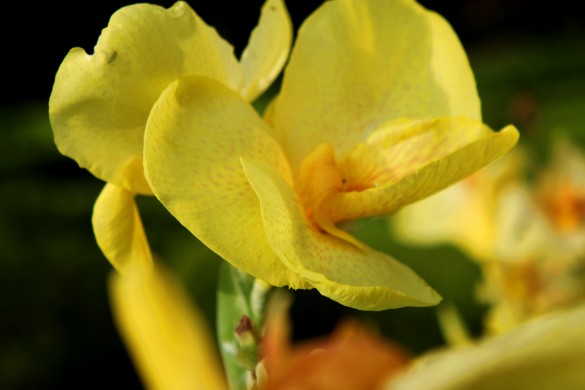Written by Ginny Mirzoyeva, Marketing Intern
Canna Lilies are actually not a true lily and are more closely related to the ginger family. They are dramatic plants whose flowers grow in a variety of shades. They are annual and tropical plants that can grow year round. Canna Lilies can be grown both indoors in containers as well outdoors in the ground. Although planting seeds is possible, Cannas are more readily grown from root-like structures known as rhizomes. These plants stand out best when planted in beds or as borders to show off their vibrant appearance. Planting, care, and maintenance are similar among all types of Cannas.
To grow Cannas from seeds, it is important to soak the seeds in hot water for two days before sowing. Prior to soaking, remove a small portion of the seed’s coat with a sharp knife. This will help moisture to penetrate the seed’s embryo and break its dormancy. After the first 24 hours the water will begin to cool off so be sure to change and add in additional hot water. Add seed starting potting mix into a germination container and water it until the mix is soaked. Let the mix drain for an hour before adding in the seeds. Be sure the seeds are planted about one inch into the mix and covered well. After the seeds have been added to the mix move the container to a sunny location, around 65 degrees Fahrenheit. The seeds will begin to sprout in about one week. Once the sprouts have reached about six inches in height they can be transplanted into individual pots as well as the garden. Be sure that all indications of frost have passed before moving them to the garden.
 To plant rhizomes pick a spot in the garden that receives direct sunlight. Plant the bulbs four to six inches deep. Place the bulbs in the soil horizontally with the eyes facing up. Cover the bulbs well and space them at least 18 inches apart. If the bulbs are planted in a pot, be sure to not over crowd the pot. Depending on how large the pot is, up to three bulbs may be planted. Add fertilizer to the soil to maintain moisture and nutrition. Continue to add fertilizer once a month to the plants. Water the cannas regularly while they are growing and ensure the soil is well draining and slightly acidic to neutral. Canna Lilies do not fare well in cold weather. Be sure to cover the plants with mulch in the fall to preserve them and maintain their vibrant foliage. If the weather is too cold for the plants to handle and frost sets in, up root the Cannas and transplant them indoors until the spring. Cut down the flowers to about three or four inches, just enough to preserve the stem. Trim and clean the bulbs to remove excess and tangled roots. The rhizomes can be dug up and stored or the plant itself replanted into an indoor pot. Be sure to store the rhizomes in a cool dark place until they are replanted, and remember to prune the plants when necessary.
To plant rhizomes pick a spot in the garden that receives direct sunlight. Plant the bulbs four to six inches deep. Place the bulbs in the soil horizontally with the eyes facing up. Cover the bulbs well and space them at least 18 inches apart. If the bulbs are planted in a pot, be sure to not over crowd the pot. Depending on how large the pot is, up to three bulbs may be planted. Add fertilizer to the soil to maintain moisture and nutrition. Continue to add fertilizer once a month to the plants. Water the cannas regularly while they are growing and ensure the soil is well draining and slightly acidic to neutral. Canna Lilies do not fare well in cold weather. Be sure to cover the plants with mulch in the fall to preserve them and maintain their vibrant foliage. If the weather is too cold for the plants to handle and frost sets in, up root the Cannas and transplant them indoors until the spring. Cut down the flowers to about three or four inches, just enough to preserve the stem. Trim and clean the bulbs to remove excess and tangled roots. The rhizomes can be dug up and stored or the plant itself replanted into an indoor pot. Be sure to store the rhizomes in a cool dark place until they are replanted, and remember to prune the plants when necessary.



